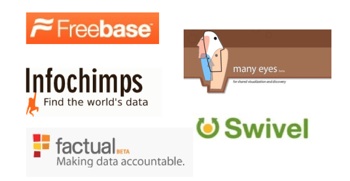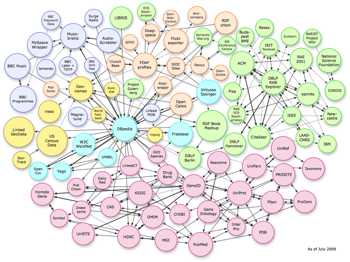Marketers love data. Web analytics, behavioral targeting, social media monitoring, audience measurement, and ever-expanding CRMs are all testament to the demand for more data about prospects and customers. But that kind of data flows one-way: from the outside world into marketing.
However, a new way of marketing with data is emerging that heralds a more significant shift for marketing — and for the web itself. It’s about reversing the flow, having marketing publish data to the outside world, as a way to increase visibility, grow relationships, and build a brand. Call it data web marketing.
Data web marketing is the product of several diverse forces: search engine optimization (SEO), web service APIs and mash-ups, the semantic web and linked data, and a new generation of data sharing and visualization sites. The common thread among all of them is data — particularly structured data — in formats that are easy for software programs to consume. Let’s take a closer look at how these different data initiatives fit together in this new kind of marketing.
Metadata for Finding and Sharing
Much of digital marketing has been centered around the production of compelling content and the promotion of such content through search, advertising, and social media. This content — text, images, video, audio — is designed for people to consume directly: reading, watching, listening. But as search engines and other agent-like services know well, processing that kind of freeform content with software into other useful applications can be challenging.
To overcome that challenge, web publishers — a label which includes most digital marketers — are increasingly encouraged to tag their content with metadata, describing it with machine-friendly RDFa or microformat vocabularies. For instance, Facebook’s Open Graph Protocol leverages such metadata to facilitate sharing among friends and like-interested communities. Google Rich Snippets and Yahoo SearchMonkey leverage such structured data to improve search results for locations, people, reviews, events, and more.
Marketers who tag their content with such metadata are rewarded with better visibility in search results and social media streams.
This is the first step towards data web marketing. It’s an incentive for marketers to start to think about deploying structured data on the web in a consistent and logical fashion. These skills are currently lumped into SEO and social media optimization (SMO). But as the metadata vocabularies used get more sophisticated — like the GoodRelations vocabulary adopted by several major online retailers such as Best Buy — the art of organizing and maintaining this metadata becomes a more significant mission unto itself.
Data APIs for Apps and Mash-ups
The next incarnation of data web marketing is evident in the proliferation of web APIs. For years, such APIs have been provided by major web players such as Google, Amazon, Facebook, and Twitter as a way to strengthen their third-party ecosystems. Enabling mash-up developers to remix key pieces of their content has helped those companies build their brands, drive affiliate revenue, and spur innovation around their core services. In the case of Twitter, these APIs have arguably been paramount to their success, as most people tweet via one or more third-party apps.
But now, organizations as diverse as The New York Times, Netflix, Compete, and Wine.com are offering APIs too. The API directory ProgrammableWeb lists over 2,000 APIs from Adgooroo to Zillow. There’s even a thriving market of service providers — including Mashery, 3scale, and Sonoa Systems — to help companies launch and maintain these APIs. What’s driving this?
Although APIs are a technical endeavor, the reasons to offer them — and the decisions about what to provide and under what terms — are rooted firmly in marketing. Generally, the motivation is one or more of these objectives:
- generate traffic back to the organization’s web site
- build brand authority by being the “reference source” in a particular area
- drive affiliate revenue with embedded links for e-commerce transactions
- strengthen relationships with power users and their respective communities
- accelerate feature innovation beyond internal development resources
The explosion of apps for the iPhone, iPad, and Android devices has further increased interest in APIs. Developers crave new sources of data they can mash up in cool, innovative ways, and publishers (i.e., marketers) are eager to extend their reach in this burgeoning app-sphere.
Here is where the shift towards outward-flowing data clearly manifests itself. Via APIs, businesses are publishing data — sometimes metadata about content, but in many cases the data itself as the content — as a marketing tactic. The quality, reliability, and usefulness of that data impacts the brand of the company that is publishing it. Therefore marketers should take a proactive role in the design and management of such services.
It’s worth noting that the distribution of data this way is a kind of “channel” to prospects and customers. Often the people who will actually buy a company’s products and services are not the people who will directly consume these APIs. Rather, the target audience is the people who will use the widgets and apps built with these APIs. The developers leveraging these APIs are, in a manner of speaking, distributors for the electronic essence of the publisher’s brand. This raises many of the classic challenges of channel marketing in a new context — balancing the needs of two very different yet interdependent constituencies.
Data as Social Media
But the migration of data from a back-office workhorse to a front-office ambassador is perhaps most apparent in the rise of data sharing and visualization sites such as Factual, Infochimps, Freebase (which was recently acquired by Google), Many Eyes, and Swivel.
These sites turn data into social media. What YouTube does for videos and Slideshare does for presentations, these sites do for data sets — let people share, search, and associate them in the social sphere. But data, unlike videos or slide decks, also lends itself to community contributions in assembling and editing data sets, enabling crowdsourced data management.
The people consuming these data sets include some of the same developers using web APIs. However, these data sets are also being downloaded by non-programmers, regular desktop users, who use them to feed spreadsheets and other business analysis applications. This broader audience demonstrates the real value data on the web can provide. Many of us crave data in our work — it helps us make decisions and persuade others. But to date, it’s been very hard to find such data in its raw form. Being able to quickly search social repositories for relevant data is a significant step forward.
Of course, the moment you have an engaged audience consuming something — in this case, data — marketers will have an interest in piggybacking on that channel to reach them. This can be a good thing, if marketers are incentivized to bring something of value to the channel. What value could marketers bring to a data web? I’d propose: good data that their audience would find useful.
As with content marketing, the strategy of such data web marketing has to be publishing things that are genuinely valuable to the intended audience — otherwise, no one’s going to bother to consume it. Such data might include industry research that the company has sponsored, aggregate performance data that customers can use for benchmarking, knowledge bases to support specific applications, and so on. Like web APIs, the benefits to marketers for producing and distributing such data are brand building, relationship building, and generating pull-through for their products and services.
Converging in the Semantic Web
So where does the semantic web fit in data web marketing? It could be argued that the semantic web — specifications such as RDF and OWL, SPARQL, and the vision of linked data — has been an elegant solution waiting for a mission. Outside the walls of enterprise IT and certain scientific communities, there just hasn’t been enough concrete demand for directly sharing data on the web. Yet.
But as publishing data becomes more popular in the contexts discussed above — SEO, web APIs, and data as social media — the advantages of adopting semantic web standards become more apparent as well. The problem with web APIs is that they’re different for each publisher, requiring developers to explicitly build and maintain their software for each one. Similarly, the data sets shared on sites like Factual and Infochimps are currently independent of each other — each its own little silo — that makes it difficult to discover and leverage relationships between them.
The semantic web was designed to address those problems. As momentum in data publishing grows, the attractiveness of its standards will grow as well, making it easier to publish and consume new data sets. By providing a common language for data, the semantic web also makes it easier for different data sets to be related to each other and to enable those relationships to be programmatically discovered by software. This is why the semantic web movement is also called “linked data.”
Perhaps most exciting, however, is that the semantic web enables all of the above data publishing scenarios to converge. SEO and SMO are already leaning towards the semantic web standard of RDFa over ad hoc microformats for encoding metadata on web pages. In addition to its web API, The New York Times now offers its data in RDF. At least one social data site, Freebase, offers an RDF interface as well. Leveraging the same formats across these different scenarios makes it easier to reuse data and software across all of them — instead of many separate pockets of online data, we can begin to view a more cohesive web of data.
In conjunction with independent community initiatives such as DBpedia and open government data programs in the U.S. and the U.K., a critical mass of such data is emerging. Like Metcalfe’s Law for networks, the more data there is in a common format — particularly one that facilitates interrelationships — the more valuable this web of data becomes. That encourages more developers to create more applications, which in turn inspires more publishers to participate by sharing more data, and a virtuous cycle can ensue.
The New Wave of Data Web Marketing
Many aspects of digital marketing today are tactical in nature, with relatively technical details driving their implementation. For instance, most CMOs and VPs of marketing don’t think about the techniques involved in good SEO. But they do care about ranking favorably on Google and Bing for topics that are core to their brands.
The fledgling scenarios of data web marketing described above, when examined individually, are largely tactical too. But when viewed collectively, they reveal a tectonic shift towards data as a new wave of web content — one that is powering a new generation of smart applications on the web and mobile devices. At that level, there are strategic opportunities that deserve executive consideration.
Just as companies who were quick to embrace the web, search marketing, and social media used that as a competitive advantage, a similar dynamic is likely to exist with the web of data.
- Whose data will be the authoritative source in each market out there?
- Whose data will be embedded in the most exciting third-party applications?
- Whose industry-specific vocabularies will become de facto standards?
- Whose open data will be most linked to within other data sets, generating a positive feedback loop around a data-level brand?
Those are strategic questions that marketers should begin thinking about.
The shift to data web marketing will take a little getting used too — we’ve had 30 years of clinging to data as something to be squirreled away. Gaining organizational experience in the web-facing data tactics above is a good start, but more forward-thinking leaders in marketing should encourage their teams to connect the dots between these initiatives. They should contemplate what Tim Berners-Lee said in an interview with Talis, advising company leaders on what the semantic web can really mean for them:
You should take an inventory of what you have got in the way of data and you should think about how valuable each piece of data in the company would be if it were available to other people across the company, or if it were available publicly, and if it were available to your partners.
That is the essence of data web marketing.






I have to wonder whether convergence on a common format really adds value or immediately commoditizes data. RSS hasn’t provided a business model for publishers, why assume RDF will? Proprietary APIs seem to have a business model, and if the data is of sufficient value — building to a particular API is a small price to pay. See Twitter, Facebook, et. al
Yes indeed, Data as a new marketing channel. The people consuming these data sets include some of the same developers using APIs. However, these data sets are also being downloaded by non-programmers, regular desktop users, who use them to feed spreadsheets and other business analysis applications. So why use data? Like Web APIs, the benefits to marketers for producing and distributing such data are brand building, relationship building and generating pull-through for their product and services.